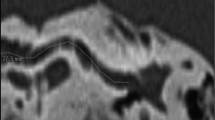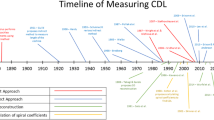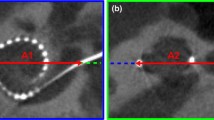Abstract
Objectives
Preoperative estimation of the insertion depth angle of cochlear implant (CI) electrodes is essential for surgical planning. The purpose of this study was to determine the cochlear size using preoperative CT and to investigate the correlation between cochlear size and insertion depth angle in morphologically normal cochlea.
Methods
Thirty-five children who underwent CI were included in this study. Cochlear duct length (CDL) and the diameter of the cochlear basal turn (distance A/B) on preoperative CT and the insertion depth angle of the CI electrode on postoperative radiographs were independently measured by two readers. Correlation between cochlear size and insertion depth angle was evaluated. Interobserver agreement was calculated using the intraclass correlation coefficient (ICC).
Results
The mean CDL, distance A, and distance B of 70 ears were 36.20 ± 1.57 mm, 8.67 ± 0.42 mm, and 5.73 ± 0.32 mm, respectively. The mean insertion depth angle was 431.45 ± 38.42°. Interobserver agreements of CDL, distance A/B, and insertion depth angle were fair to excellent (ICC 0.864, 0.862, 0.529, and 0.958, respectively). Distance A (r = − 0.7643) and distance B (r = − 0.7118) showed a negative correlation with insertion depth angle, respectively (p < 0.0001). However, the correlation between CDL and insertion depth angle was not statistically significant (r = − 0.2333, p > 0.05).
Conclusions
The CDL and cochlear distance can be reliably obtained from preoperative CT. Distance A can be used as a predictive marker for estimating insertion depth angle during CI surgery.





Similar content being viewed by others
Abbreviations
- BTL:
-
Length of the cochlear basal turn
- CDL:
-
Cochlear duct length
- CI:
-
Cochlear implantation
- CT:
-
Computed tomography
- ICC:
-
Intraclass correlation coefficient
- TBCT:
-
Temporal bone computed tomography
References
Wanna GB, Noble JH, Gifford RH et al (2015) Impact of intrascalar electrode location, electrode type, and angular insertion depth on residual hearing in cochlear implant patients: preliminary results. Otol Neurotol 36:1343–1348
Hochmair I, Arnold W, Nopp P, Jolly C, Müller J, Roland P (2003) Deep electrode insertion in cochlear implants: apical morphology, electrodes and speech perception results. Acta Otolaryngol 123:612–617
Hochmair I, Hochmair E, Nopp P, Waller M, Jolly C (2015) Deep electrode insertion and sound coding in cochlear implants. Hear Res 322:14–23
Roy AT, Penninger RT, Pearl MS et al (2016) Deeper cochlear implant electrode insertion angle improves detection of musical sound quality deterioration related to bass frequency removal. Otol Neurotol 37:146–151
O’Connell BP, Cakir A, Hunter JB et al (2016) Electrode location and angular insertion depth are predictors of audiologic outcomes in cochlear implantation. Otol Neurotol 37:1016
Adunka O, Kiefer J (2006) Impact of electrode insertion depth on intracochlear trauma. Otolaryngol Head Neck Surg 135:374–382
Welling DB, Hinojosa R, Gantz BJ, Lee JT (1993) Insertional trauma of multichannel cochlear implants. Laryngoscope 103:995–1001
Gstoettner W, Pok S, Peters S, Kiefer J, Adunka O (2005) Cochlear implantation with preservation of residual deep frequency hearing. HNO 53:784–790
Erixon E, Rask-Andersen H (2013) How to predict cochlear length before cochlear implantation surgery. Acta Otolaryngol 133:1258–1265
Dimopoulos P, Muren C (1990) Anatomic variations of the cochlea and relations to other temporal bone structures. Acta Radiol 31:439–444
Avci E, Nauwelaers T, Lenarz T, Hamacher V, Kral A (2014) Variations in microanatomy of the human cochlea. J Comp Neurol 522:3245–3261
Hardy M (1938) The length of the organ of Corti in man. Am J Anat 62:291–311
Kawano A, Seldon HL, Clark GM (1996) Computer-aided three-dimensional reconstruction in human cochlear maps: measurement of the lengths of organ of Corti, outer wall, inner wall, and Rosenthal’s canal. Ann Otol Rhinol Laryngol 105:701–709
Ketten DR, Skinner MW, Wang G, Vannier MW, Gates GA, Gail Neely J (1998) In vivo measures of cochlear length and insertion depth of nucleus cochlear implant electrode arrays. Ann Otol Rhinol Laryngol Suppl 175:1–16
Meng J, Li S, Zhang F, Li Q, Qin Z (2016) Cochlear size and shape variability and implications in cochlear implantation surgery. Otol Neurotol 37:1307–1313
Würfel W, Lanfermann H, Lenarz T, Majdani O (2014) Cochlear length determination using cone beam computed tomography in a clinical setting. Hear Res 316:65–72
Escudé B, James C, Deguine O, Cochard N, Eter E, Fraysse B (2006) The size of the cochlea and predictions of insertion depth angles for cochlear implant electrodes. Audiol Neurootol 11:27–33
Koch RW, Ladak HM, Elfarnawany M, Agrawal SK (2017) Measuring cochlear duct length–a historical analysis of methods and results. J Otolaryngol Head Neck Surg 46:19
Catmull E, Rom R (1974) A class of local interpolating splines. In: Computer aided geometric design. Academic Press, New York, pp 317–326
Yuksel C, Schaefer S, Keyser J (2011) Parameterization and applications of Catmull–Rom curves. Comput Aided Des 43:747–755
Alexiades G, Dhanasingh A, Jolly C (2015) Method to estimate the complete and two-turn cochlear duct length. Otol Neurotol 36:904–907
Xu J, Xu S-A, Cohen LT, Clark GM (2000) Cochlear view: postoperative radiography for cochlear implantation. Otol Neurotol 21:49–56
Svrakic M, Friedmann DR, Berman PM, Davis AJ, Roland JT Jr, Svirsky MA (2015) Measurement of cochlear implant electrode position from intraoperative post-insertion skull radiographs: a validation study. Otol Neurotol 36:1486
Rivas A, Cakir A, Hunter JB et al (2017) Automatic cochlear duct length estimation for selection of cochlear implant electrode arrays. Otol Neurotol 38:339–346
Iyaniwura JE, Elfarnawany M, Riyahi-Alam S et al (2017) Intra- and interobserver variability of cochlear length measurements in clinical CT. Otol Neurotol 38:828–832
Iyaniwura JE, Elfarnawany M, Ladak HM, Agrawal SK (2018) An automated A-value measurement tool for accurate cochlear duct length estimation. J Otolaryngol Head Neck Surg 47:1–8
Acknowledgments
The authors would like to thank Prof. Sang Joon Park for his support to quantitative image analysis and Professor Emeritus In-One Kim for his support to manuscript editing.
Funding
None.
Author information
Authors and Affiliations
Corresponding author
Ethics declarations
Guarantor
Jung-Eun Cheon.
Conflict of interest
None.
Statistics and biometry
No complex statistical methods were necessary for this paper.
Informed consent
Written informed consent was waived by the Institutional Review Board.
Ethical approval
Institutional Review Board approval was obtained.
Methodology
• retrospective
• observational study
• performed at one institution
Additional information
Publisher’s note
Springer Nature remains neutral with regard to jurisdictional claims in published maps and institutional affiliations.
Rights and permissions
About this article
Cite this article
Oh, J., Cheon, JE., Park, J. et al. Cochlear duct length and cochlear distance on preoperative CT: imaging markers for estimating insertion depth angle of cochlear implant electrode. Eur Radiol 31, 1260–1267 (2021). https://doi.org/10.1007/s00330-020-07580-4
Received:
Revised:
Accepted:
Published:
Issue Date:
DOI: https://doi.org/10.1007/s00330-020-07580-4




